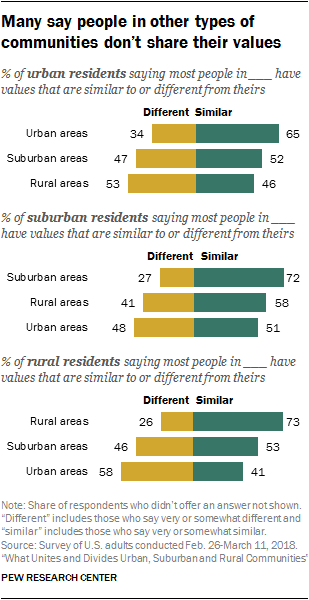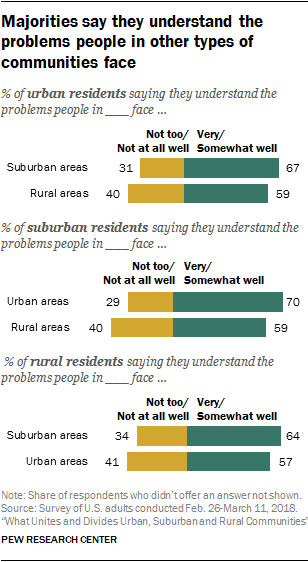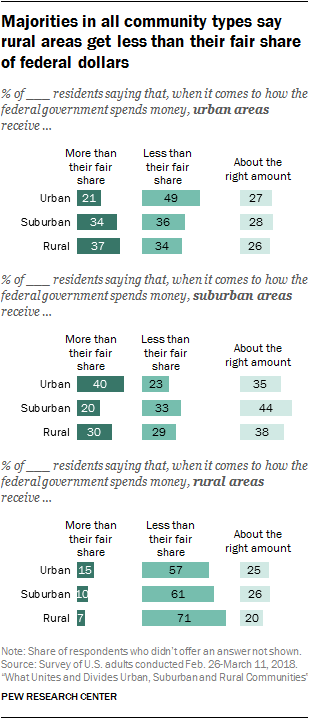
Most Americans in urban, rural and suburban areas say people who live in the same type of community as they do generally share their values, but they are less convinced about those in other types of communities. This is particularly the case in rural areas, where about six-in-ten say most people who live in cities have values that are different from their own, but substantial shares of urban and suburban dwellers also see differences between their values and those in other community types.
Majorities of urban and rural residents alike say that people who don’t live in their type of community have a very or somewhat negative view of those who do (63% in urban and 56% in rural areas). About two-thirds or more in urban and rural areas (65% and 70%, respectively) also say people in other types of communities don’t understand the problems people in their communities face.
In contrast, most suburbanites (60%) say people who don’t live in the suburbs have a very or somewhat positive view of those who do. And suburbanites are about evenly divided on the extent to which others understand the types of problems suburban communities face: 45% say they do and 52% say they don’t.
At the same time, majorities in urban, rural and suburban areas say they themselves understand the problems people in other types of communities face. For example, 67% of urban dwellers say they understand the problems faced by those in the suburbs very or somewhat well, and 59% say they understand the problems faced by those in rural areas. Similarly, 64% in rural areas say they understand the problems facing those in the suburbs and 57% say they understand the problems urban dwellers face.
When it comes to how the federal government spends its money, majorities of Americans across community types say rural areas receive less than their fair share. There’s less agreement on the amount of resources that are going to cities: A 49% plurality of urban residents say their type of community receives less than their fair share from the federal government; smaller shares of suburban and rural residents share this view. Opinions are mixed when it comes to federal spending in suburban areas.
A majority of rural Americans see a values gap between themselves and urban dwellers

About seven-in-ten adults in rural (73%) and suburban (72%) areas, and 65% in urban areas, say most people who live in the same type of community as they do have values that are very or somewhat similar to their own. When it comes to whether they have values in common with people who live in other types of communities, however, the public is more divided.
Among urban dwellers, 46% say most people in rural areas have values that are similar to theirs, while 53% say the values of rural Americans are very or somewhat different. This is in line with the way urban adults view those in the suburbs: 52% say people in the suburbs generally share their values, 47% say they don’t.
Like those in urban areas, rural residents are also divided on whether the values of suburbanites are generally similar to (53%) or different from (46%) theirs. But a majority of rural dwellers (58%) say urban Americans have values that are very or somewhat different from their own.
Suburbanites are somewhat more likely to say they have values in common with people in rural areas than with those who live in cities: 58% in the suburbs say most people in rural areas have values that are very or somewhat similar to theirs, compared with 51% who say the same about people in urban areas.
Majorities of urban and suburban Democrats see a values divide with rural residents; most suburban and rural Republicans say people in cities don’t share their values

In urban and suburban communities, perceptions of a values divide with those who live in rural areas vary significantly across party lines. Most Republicans and Republican-leaning independents in these types of communities (64% in urban and 78% in suburban areas) say most people in rural areas have values that are very or somewhat similar to theirs. In contrast, majorities of Democrats and Democratic-leaning independents in urban (59%) and suburban (58%) areas say the values of people in rural areas are generally different from theirs; this is particularly the case among urban and suburban Democrats with a bachelor’s degree or more education as well as those who describe their political views as liberal.
Partisanship is also linked to how people in suburban and rural communities see the values of those who live in cities relative to their own. In the suburbs, 65% of Democrats say most people in urban areas have values that are similar to theirs; only about a third of suburban Republicans (34%) say the same.
The partisan gap is somewhat smaller but still significant among rural dwellers. While just about a third of rural Republicans (34%) say people in urban areas have values that are very or somewhat similar to theirs, rural Democrats are about evenly divided, with 49% saying the values of people in cities are similar to and 50% saying they are different from their own values.
Even among Republicans who themselves live in urban areas, only about half (48%) say most people in cities share their values. By comparison, majorities of Republicans in suburban (75%) and rural (82%) communities say most people in their community type have values that are similar to theirs; majorities of Democrats across urban (72%), suburban (70%) and rural (63%) communities also say people in their type of community generally share their values.
This perceived values gap doesn’t extend to views of the suburbs. Across community types, Republicans and Democrats offer similar perceptions of whether the values of most people in suburbs are similar to or different from their own.
Majorities in urban and rural areas say others have a negative view of people in their type of community

In urban and rural areas alike, more than half (63% and 56%, respectively) say people who don’t live in their type of community have a very or somewhat negative view of those who do. In contrast, 60% of those in suburban areas say most people who live outside of the suburbs have a very or somewhat positive view of suburban residents.
For the most part, opinions on this don’t vary across demographic groups, but urban and rural residents with a bachelor’s degree or more education are more likely than their less educated counterparts to say those outside of urban and rural areas have a negative view of those who live in these types of communities. About seven-in-ten college graduates in urban (72%) and rural (69%) areas say others have a negative view of people in their community type; 59% of those with some college or less education in urban areas and 53% in rural areas say the same.
Most urban and rural Americans say people in other types of communities don’t understand the problems people in their community face

Solid majorities in rural (70%) and urban (65%) areas say people who live outside of these areas don’t understand the types of problems faced in these types of communities; smaller shares in suburban areas (52%) say most people in other types of communities don’t understand the problems suburbanites face. Suburban residents who say they live very far from the city are more likely than those who live very close or somewhat close to the city to say most people who don’t live in the suburbs don’t understand the types of problems they face (66% vs. 49% and 50%, respectively).
While there are no racial differences in the views of urban and suburban dwellers, whites in rural areas are far more likely than their nonwhite counterparts to say people outside of rural areas don’t understand the types of problems people in their type of community face: 74% of rural whites say this is the case vs. 57% of nonwhites in rural parts of the country.
Among rural and urban dwellers, those with more education are particularly likely to feel that others lack understanding of the types of problems people in their type of community face. For example, 82% of rural residents with a bachelor’s degree or more education – vs. 74% of those with some college experience and 63% with a high school diploma or less – say people outside of rural areas don’t understand the types of problems rural Americans face. In cities, 73% of college graduates and 67% of those with some college experience say people outside of urban areas don’t understand the types of problems people in their community face; 56% of those with a high school diploma or less education say this is the case.
Majorities say they understand the problems faced in other types of communities
While many Americans, particularly in urban and rural areas, don’t think others understand the problems people in their type of community face, majorities say they personally understand the problems faced by people in other types of communities very or somewhat well. This is the case among urban, suburban and rural residents asked about each of the other two types of communities.

Among those in urban areas, 67% say they understand the types of problems people in the suburbs face; 59% say the same about the problems experienced by rural residents. Similarly, majorities of suburbanites say they understand the types of problems people in urban (70%) and rural (59%) areas face, and majorities of rural dwellers say they understand the types of problems people in suburban (64%) and urban (57%) communities experience.
Perhaps not surprisingly, people in urban, rural and suburban areas who grew up in a different type of community are particularly likely to say they understand the problems faced by those who live in the type of community where they grew up. For example, 81% of urban dwellers who grew up in a rural area say they understand the problems people in rural areas face, compared with 55% of current urban residents who grew up in an urban area and 48% of those who grew up in a suburb.
In urban and suburban communities, Republicans and Republican-leaning independents are more likely than Democrats and those who lean Democratic to say they understand the problems faced by people in rural areas. At least two-thirds of Republicans in cities (72%) and suburbs (67%) – vs. 54% and 53% of Democrats, respectively – say this. There is also a partisan gap in rural communities, with a higher share of Democrats (64%) than Republicans (54%) saying they understand the types of problems people in urban areas face.
Across community types, majorities say rural areas get less than their fair share of federal dollars

Majorities of Americans in rural (71%), suburban (61%) and urban (57%) communities say that, when it comes to how the federal government spends money, rural areas receive less than their fair share. Views are more mixed when it comes to the amount of money urban and suburban areas receive from the federal government.
For the most part, opinions about whether urban, rural and suburban areas get more than their fair share, less than their fair share, or about the right amount of money from the federal government don’t vary significantly across demographic or party lines, but some sharp partisan differences emerge when it comes to assessments of how much money urban areas receive.
By wide margins, Republicans and Republican-leaning independents in urban, rural and suburban communities are far more likely than their Democratic and Democratic-leaning counterparts to say urban areas receive more than their fair share from the federal government (40% vs. 15% in cities, 51% vs. 22% in suburbs and 47% vs. 28% in rural areas). Meanwhile, higher shares of Democrats than Republicans say urban areas receive less than their fair share (57% vs. 25% in cities, 50% vs. 18% in suburbs and 44% vs. 24% in rural areas). Similar shares of Democrats and Republicans within each community type say urban areas receive about the right amount of federal dollars.




